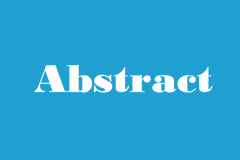摘要(Abstract)是现代科技论文中必不可少的内容,国标(GB 6447-86)将摘要的定义为:“以提供文献内容梗概为目的,不加评论和补充解释,简明、确切地记述文献重要内容的短文”。英文摘要作为英文论文的重要组成部分,有其特殊的意义和作用,它是国际间知识传播、学术交流与合作的“桥梁”和媒介。尤其是目前国内外各知名检索机构的数据库对英文摘要的依赖性很强,因此,好的英文摘要对于增加期刊和论文的被检索和引用机会、吸引读者、扩大影响起着不可忽视的作用。下面为大家整理了一些医学英文论文摘要写作的要点和注意事项
英文摘要限500个实词左右,一般须以第三人称过去式叙述。用词准确,逻辑性强,结构严谨。结果和结论一般用句子表达;而目的、方法(设计、地点和对象)等,则常用短语表达。
(1)英文摘要的时态与语态
1)说明研究目的,通常用一般现在时或一般过去时。
2)说明方法和结果,一般用一般过去时、第三人称的被动语态表达。
3)结论通常用一般现在时、被动语态表达,也可用主动语态表达。
(2)常用句型
1)表达论文内容的常用句型
A 第三人称主动态
①This paper(article,report)describes…本文叙述…
②This paper (article)reports…本文报告…
③This report(paper,article)presents…本文介绍…
④This paper(article,report)discusses…本文讨论…
常用的动词还有analyze(分析),evaluate(评价),compare(比较),describe(描述)等。
B 第一人称主动态
⑤We report(on)…我们报告…
⑥We describe a case of… 我们描述1例…
⑦In this paper,we present… 本文介绍…
⑧In this paper,we report… 本文报告…
主语除we之外,还可用the authors(作者)等。
C 一般现在时被动语态
⑨A case is reported in which… 本文报告1例…
⑩A study of…is reported本文报告…的研究
⑧…is(are)described. 本文描述…
⑥In this paper.…is(are)presented. 本文介绍…
2)表达目的常用句型
A 一般过去时、被动语态
①The purpose(aim,objective) of this study was to… 本研究旨在…
②The goal(aim) of this investigation was to… 本研究旨在…
③This study was designed to… 本研究旨在…
④This study was undertaken to… 本研究旨在…
⑤This prospective study was performed to… 本前瞻性研究的目的是…
⑥A study to…was carried out(during) (在…期间)所作研究的目的是…
⑦An attempt has been made to… 为了…而作试验
B 动词不定式短语
To evaluate,report,investigate,study,analyze…
C 一般过去时、主动语态
⑧We(the authors)conducted a study to… 为了…我们进行了研究
⑨To determine…,we studied… 为了确定…,我们研究了…
⑩In an attempt to…,in an effort to…或in order to…,we carried out a pilot study… 为了…,我们进行了…的初步研究
表示目的的常用动词有:evaluate(评价),examine(检查,观察),determine(确定,查明),elucidate(阐明),explore(探索),test(测试),compare(比较),estimate(评估),assess(估价),investigate(调查)等。
3)表达方法的常用句型
A 方法
表达研究类型 Prospective, Retrospective, Cohort,Case-control,in vivo, in vitro
①Using…(technique),we studied… 我们用…(技术)研究了…
②Using…,it was found that… (我们)用…发现了…
③…was(were)measured using… (我们)用…测定了…
④…was(were)analyzed (reviewed) by… (我们)用…分析(回顾)了…
⑤…was(were)treated with… (我们)用…治疗了…
⑥…measurements were made of… 测定了…
常用的动词还有:study,measure,determine, investigate,isolate,demonstrate,examine,identify等。
B 分组(主语通常为patients,subjects,animals)
⑦…were randomly divided (grouped) into…groups …被随机分成…组
⑧…were separated into…groups based on… 根据…,将…分成…组
⑨The groups were as follows: 分组如下:
C 治疗或检查方法
⑩… was performed(used) in (on)…patients 我们对…患者施行(应用)了…
(patients) underwent…endoscopy (患者)进行了…内镜检查
Surgical procedures, assay(immunohistochemistry, molecular biology…) 手术方法,测试方法…
C 统计学方法
Statistical methods: Student’s t test, χ2 … was used for
4)表达结果的常用句型
A 一般句型
①The results showed (demonstrated) that…结果表明…
②It was found that… (我们)发现…
③It was observed that… (我们)观察到…
第②和③句也可改为第一人称:We found that…和We observed that…。
B 增加或减少
④…decreased by(40%)…降低(40%)…
⑤…(a 70%) reduction in…was observed …观察到…降低(70%)
⑥There was a(15%) elevation in……增高(15%)
⑦…resulted in (a marked) increase in… …导致…(明显)增高
⑧…was lowered from…to… …从…下降到…
表达增加或减少的常用动词还有rise,raise,decline,drop,fall,lower等。可用by表示是净增减的数或倍数,例如“…increase by 40%”,表示“增加40%”;而to表示增加或减少到某个具体数值。
C 相关与差别
⑨There was a significant linear correlation between…and… …与…有显著的线性相关性
⑩…showed no strong correlation between…and… …显示…与…无密切相关性
⑩…correlated positively with… …与…呈正相关
⑥A negative correlation was found between…and… 发现…与…呈负相关
⑩There was (were)(no)significant difference(s)or (No)significant difference(s)was found(observed) between…and… …与…之间…(无)有显著差别
P value P值(需写出具体数字)
⑩…was closely related to… …与…密切相关
表示相互关系的常用词还有relationship(关系),association(联系),regression(回归)。
D 表示改善或保持
⑩…demonstrated a significant improvement in… …方面呈明显改善
⑩…values returned to (preoperative)levels …值恢复到(手术前)水平
⑩…remained at a mean of… …保持在…平均值水平
5)表达结论的常用句型
A 常用提示句型
①These results suggest that…结果提示…
②These findings indicate that… 这些发现表明…
③The data (study)show the need for… 数据(研究)表明需要…
④The results support the concept that… 结果支持…的概念
⑤Our observations confirm that… 我们的观察证实…
imply(提示),demonstrate(证明)和illustrate(说明)
B 做出结论或建议
⑥We conclude that… 我们的结论是…
⑦We suggest that…我们建议…
⑧We believe that… 我们认为…
⑨We postulate that…我们设想…
⑩It is concluded that… 结论是…
⑩It is suggested (proposed)that… 结果提示…,建议…(虚拟语气)
⑥It is recommended that… 建议…
⑩It is estimated that… 估计…
…is(are)suggested(recommended)
…propose …as
C 表示一致性
⑩These results accord with… 结果与…一致
⑩The results are concordant with…结果与…一致
⑧The results agree well with…结果与…一致
be consistent with,in accordance with(…与…一致)
to parallel(与…相平行)
D 结果转向结论
⑥Thus,therefore,hence …因此,…
⑥In conclusion.…最后,…
⑩From this study,we conclude that…根据本项研究,我们的结论是…
⑧These findings,coupled with the observation that…,suggest that…这些发现连同对…的观察结果一起,提示…
⑨In the light of this experience we therefore conclude that… 根据这个经验,我们得出…的结论
E 表达今后方向
The mechanisms by which…remain to be investigated关于…的机制仍需研究
Further studies are necessary to (evaluate)… 有必要进一步研究,以(评价)…
注:按MEDLINE要求,PURPOSE,METHODS,RESULTS,CONCLUSIONS全部用大写,后加冒号。英文必须在半角状态下输入,不能全角、半角混用。
注意,这些东西一定不要出现在英文摘要里面:不常见的术语,插图,表格,数学公式,化学方程式,中文标点,过多的形容词,无关的背景资料,自我评价等。
留学生代写网:专业网课代修、英文作业代写平台。客服QQ:800056654


